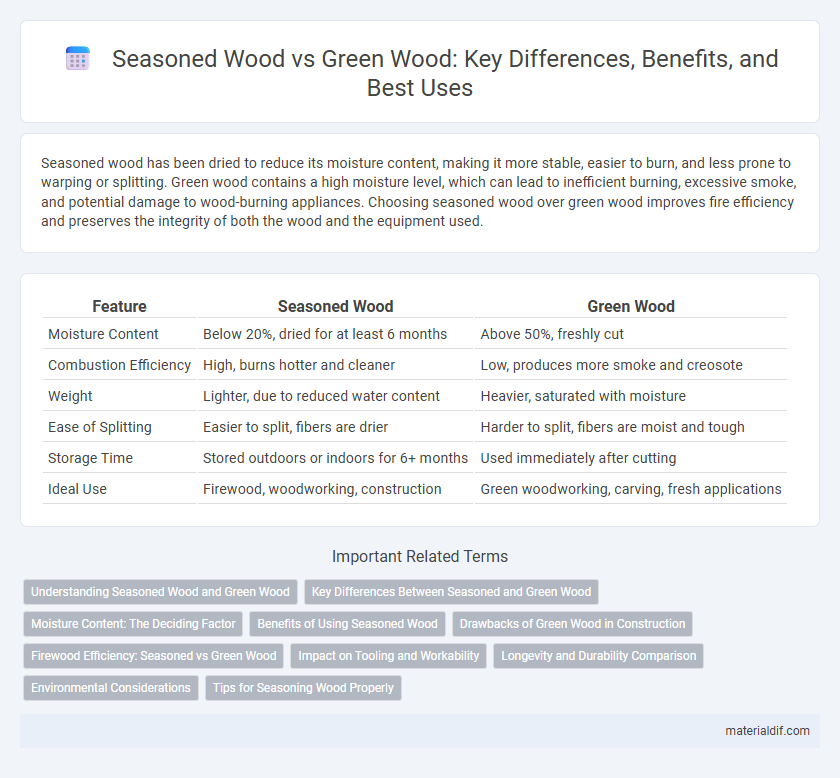Seasoned wood has been dried to reduce its moisture content, making it more stable, easier to burn, and less prone to warping or splitting. Green wood contains a high moisture level, which can lead to inefficient burning, excessive smoke, and potential damage to wood-burning appliances. Choosing seasoned wood over green wood improves fire efficiency and preserves the integrity of both the wood and the equipment used.
Table of Comparison
| Feature | Seasoned Wood | Green Wood |
|---|---|---|
| Moisture Content | Below 20%, dried for at least 6 months | Above 50%, freshly cut |
| Combustion Efficiency | High, burns hotter and cleaner | Low, produces more smoke and creosote |
| Weight | Lighter, due to reduced water content | Heavier, saturated with moisture |
| Ease of Splitting | Easier to split, fibers are drier | Harder to split, fibers are moist and tough |
| Storage Time | Stored outdoors or indoors for 6+ months | Used immediately after cutting |
| Ideal Use | Firewood, woodworking, construction | Green woodworking, carving, fresh applications |
Understanding Seasoned Wood and Green Wood
Seasoned wood refers to lumber that has been dried to reduce its moisture content, typically to 15-20%, enhancing its stability and combustion efficiency. Green wood is freshly cut timber containing high moisture levels, often exceeding 50%, which can cause it to warp, crack, or produce excessive smoke when burned. Understanding the differences in moisture content and drying processes between seasoned and green wood is essential for applications in construction, woodworking, and firewood use.
Key Differences Between Seasoned and Green Wood
Seasoned wood has a moisture content below 20%, making it ideal for efficient burning and structural use, while green wood typically contains over 50% moisture, leading to slower drying and increased smoke production. Seasoned wood is lighter, cracks when split, and produces more heat, whereas green wood is heavier, harder to ignite, and prone to warping. Understanding the moisture content and drying process is crucial for selecting wood suitable for construction or firewood purposes.
Moisture Content: The Deciding Factor
Seasoned wood contains moisture content typically between 6% and 20%, making it stronger, more stable, and less prone to warping or cracking compared to green wood, which can have moisture levels exceeding 50%. The high moisture content in green wood causes slower drying times and increased susceptibility to fungal decay and insect infestation. Choosing seasoned wood ensures better durability and efficiency in woodworking and construction due to its lower moisture content.
Benefits of Using Seasoned Wood
Seasoned wood offers superior durability and stability compared to green wood, reducing the risk of warping, cracking, and shrinking during use. Its lower moisture content improves combustion efficiency, resulting in longer-lasting and cleaner fires. Working with seasoned wood also enhances tool longevity and craftsmanship precision due to its reduced hardness and increased predictability.
Drawbacks of Green Wood in Construction
Green wood contains high moisture content, leading to significant shrinkage and warping as it dries, which compromises structural integrity in construction. Its susceptibility to fungal decay and insect infestation increases the risk of damage over time. Additionally, green wood is heavier and more difficult to work with, reducing efficiency during building processes.
Firewood Efficiency: Seasoned vs Green Wood
Seasoned wood has lower moisture content, typically below 20%, resulting in higher firewood efficiency due to better combustion and less smoke production compared to green wood, which contains 40-60% moisture. The higher moisture in green wood reduces heat output as energy is consumed evaporating water, leading to inefficient burning and increased creosote buildup in chimneys. Therefore, using seasoned wood enhances heat generation, reduces fuel consumption, and decreases maintenance related to soot and creosote deposits.
Impact on Tooling and Workability
Seasoned wood, with its lower moisture content typically around 6-8%, offers enhanced tooling performance by reducing blade wear and minimizing tool dulling compared to green wood, which can have moisture levels exceeding 30%. The hardness and stability of seasoned wood improve workability by allowing cleaner cuts, reducing splitting, and providing consistent results, while green wood's high moisture can cause tools to bind and wood fibers to tear. Proper drying of wood ensures efficient woodworking processes, extending tool life and delivering higher-quality finished products.
Longevity and Durability Comparison
Seasoned wood, with its reduced moisture content of 6-20%, offers superior longevity and durability compared to green wood, which retains 30-60% moisture, leading to faster decay and susceptibility to warping. The controlled drying process of seasoned wood enhances its resistance to fungal growth and insect infestation, making it ideal for construction and furniture. In contrast, green wood's high moisture promotes splitting and structural weaknesses, reducing its lifespan in outdoor or load-bearing applications.
Environmental Considerations
Seasoned wood has a lower moisture content, resulting in more efficient burning and reduced emissions compared to green wood, which releases higher levels of smoke and pollutants due to its high moisture. Using seasoned wood helps conserve forest resources by maximizing heat output and minimizing waste during combustion. Harvesting and drying wood responsibly further supports sustainable forestry practices and mitigates carbon footprint impacts.
Tips for Seasoning Wood Properly
Seasoned wood has a moisture content below 20%, making it ideal for burning, while green wood contains over 50% moisture and burns inefficiently. To season wood properly, stack logs off the ground in a well-ventilated, sunny area and cover the top to protect from rain without sealing the sides, allowing air circulation. Splitting logs into smaller pieces accelerates drying by increasing surface area and promoting moisture evaporation.
Seasoned Wood vs Green Wood Infographic

 materialdif.com
materialdif.com